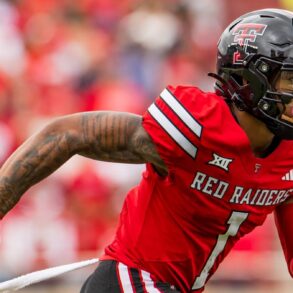OAKLAND, Calif. — Around 8:07 a.m. PT on Monday, an older bespectacled woman with curly graying hair, wearing a leather jacket and carrying a beige tote bag and black purse, crossed Jefferson Street in downtown Oakland on a cold, rainy morning.
The woman walked up two flights of marble steps, entered the Ronald V. Dellums Federal Building and U.S. Courthouse and then slipped quietly into an employee entrance within the building’s main lobby.
Advertisement
That woman, California judge Claudia Wilken, holds decision-making power that stands to alter the future of college athletics.
Two hours after she entered the building, within a small third-floor courtroom and in front of about 75 people and hundreds more watching online, Wilken presided over a near seven-hour court proceeding that marked the final hearing in the NCAA’s House settlement agreement.
In the end, the 75-year-old retiring judge indicated that she would, indeed, approve the settlement if changes are made specifically to two concepts: (1) provide a phase-in period for implementing new roster limits or “grandfather in” current athletes on rosters; and (2) adjust language related to binding future athletes to the 10-year settlement.
In the final five minutes of the hearing, Wilken more than tipped her hand: She wants to approve the settlement.
Advertisement
“Basically, I think it is a good settlement,” she said. “I think it’s worth pursuing. I think some of these things can be fixed.”
It was a somewhat groundbreaking moment — a booming revelation from a sitting federal judge about such a historically significant agreement that stands to reshape college sports. The NCAA and power conference’s settlement of three antitrust cases — House, Hubbard and Carter, all of them legal challenges over athlete compensation — will usher in the age of athlete revenue sharing, with billions of dollars expected to be shared with current and future athletes in a capped system, and another $2.8 billion assigned to past athletes in backpay.
Will the NCAA and power conferences make the required changes?
“We’re going to take a look at some things,” NCAA attorney Rakesh Kilaru said. “At the end of the day, we came to the court today with a good settlement that we think is workable for the class and is good for college sports moving forward.”
Advertisement
The change to the roster limits looms as the key issue, one that’s been festering now for months.
In fact, of the parade of objectors who appeared in court Monday before the judge, many focused their critiques on the implementation of roster limits, which are imposed on schools that opt into the House settlement’s revenue-sharing concept. While the NCAA and power conferences agreed to expand upon scholarships as part of the settlement — schools are now permitted, not required, to scholarship every player on a roster — they also imposed sport roster limits that did not previously exist.
(Grant Thomas/Yahoo Sports)
The new roster limits are expected to lead to the elimination of thousands of Division I roster spots, most notably impacting walk-ons and partial scholarship earners in swimming, football, track and cross country, as detailed in stories in October and January at Yahoo Sports. High school athletes, recruited for months by schools and even offered scholarships, are having their offers revoked as coaches trim rosters to meet the new limits. Current athletes are seeing their spots eliminated.
Advertisement
Wilken was clear: Change the roster limit situation or risk not having me approve the settlement.
“My idea is to grandfather in” those currently on rosters, she told lawyers. “It would save a lot of angst.”
The defendant attorneys in the case — the NCAA and power conferences — have so far refused to make such a change, even though the plaintiff attorneys have publicly supported that idea. In an interview in the fall with Yahoo Sports, Steve Berman, one of the lead plaintiff attorneys who struck the settlement with the NCAA, said both sets of attorneys were “working” with the NCAA and power leagues for solutions, including a transitional period in which those currently on a roster are grandfathered into the system.
However, it never happened.
Advertisement
Now, a federal judge with the power to strike down the settlement — a ruling that could send the NCAA into a long, costly court fight — is asking for the change to be made.
“We’ve got to talk to our clients about it,” Kilaru said afterward.
Attorneys are to report back to Wilken in one week to determine if the changes can be made, but she granted them more time if they need it. Jeffrey Kessler, the co-lead for the plaintiffs with Berman, told the judge that “these are things we are able to address.”
But Kilaru stopped short of agreeing to changes during a frenzied final 90 minutes of the hearing, where Wilken peppered Kilaru and Kessler with questions around her most pressing issues with the settlement agreement.
Advertisement
All the while, hovering over the final minutes of the proceeding, was a deadline of 5 p.m. PT, when the courthouse’s doors were to be locked and the building closed to visitors and even court officials. Signs in the lobby and common areas noted that all persons should be out of the building by 5 p.m., and the judge announced the closing time during the hearing’s final hour.
It was a bizarre scene — a federal judge rapidly moving through items of one of the most consequential cases in college sports history because of an arbitrarily set closing time in a federal building.
Miffed at the closing time, Wilken even cracked a joke. Of course, the building could be kept open, she said, “but it’s the government.”
“I’m trying to get you out of here before you get locked in,” she told those present with a smile.
Advertisement
At 4:33 p.m. PT, the hearing ended and attorneys filtered out of the building and into a courtyard to discuss what they believe was a mostly positive hearing for those in support of the settlement.
After all, said Kessler, the judge announced that the settlement was good. “We are gratified” at her statement, he said. After attorneys adjust the recommended language, Berman said he “hopes” the judge will approve the agreement within the next three weeks.
“We think we can get it over the finish line,” he said.
There were plenty of positives for those supporting the settlement.
For instance, based on her line of questioning and commentary, Wilken will not entertain a number of objections, waiving most of them off during Monday’s hearing. Those include issues raised around Title IX’s implication on the distribution of backpay to athletes (90% to men); the new enforcement system that is expected to more strictly regulate third-party and booster NIL payments to athletes; and claims that the revenue share cap is anticompetitive.
Advertisement
She instead turned most of her attention to two concepts: the new roster limits and the settlement’s injunctive class. Athletes, even those not currently in college, are automatically part of the 10-year settlement’s injunctive class that releases any future legal claims that they might have.
Wilken describes it as a “difficult concept,” she told attorneys. “I’m having trouble with binding people who aren’t here and releasing claims for things that haven’t happened.”
She recommended that attorneys adjust language in the settlement agreement so that future athletes are only part of the injunctive class once they are provided an opportunity to object to the deal after joining a Division I athletic program. Speaking on behalf of the NCAA and power leagues, Kilaru said the 10-year injunctive class is necessary and without it, “there will not be stability and there will not be a deal,” he said in a thundering message to Wilken.
“See what you think you can do about all these issues,” the judge told Kilaru. “Maybe some you can fix or some you can’t but can give (me) a better exclamation.”
Advertisement
While a minor language change provides a solution for that issue, the roster limit situation looms as more problematic, some believe.
The roster and scholarship structure can be complex and difficult to understand. Under previous rules, most NCAA sports featured a scholarship limit (different by sport) but few sports had a finite roster cap. For example, the sport of men’s volleyball was allotted just 4.5 scholarships but often kept on its roster as many as 25 players, or however many the school permitted.
As part of the new policy, scholarship caps were removed, replaced by formal roster limitations. The difference between a sport’s new roster limit and its current roster are drastic in a handful of sports. For instance, many cross country teams keep more than 30 runners on a roster; the new roster limit is 17.
Advertisement
Grayson Laudermilch, a high school track runner who had her scholarship and roster spot eliminated after committing to a school, appeared in court in a passionate and emotional plea to the judge. “Roster limits destroy the dreams of athletes throughout the nation,” she said. “Our future is held in your hands. Can you help us understand why colleges are banning together to limit us? Your honor, please deny this settlement.”
According to those with knowledge of the settlement negotiations, power conference leaders implemented the new roster structure as a way to preemptively avoid any legal challenges over the previous scholarship restrictions. But there is perhaps another reason too: save money.
With many power conference schools sharing a previously not-budgeted $20 million-plus annually with athletes, the elimination of many walk-ons could save thousands.
Even the named plaintiffs in the case don’t completely agree with the roster limit situation. Grant House, the former Arizona State swimmer and leading named plaintiff, told Yahoo Sports in December that he “never signed anything” to limit rosters. In fact, House and TCU basketball player Sedona Prince, another plaintiff, appeared in the courthouse on Monday and were seated in the front row.
Advertisement
Many of those present at the hearing — most notably, the general counsels of the power conferences — are flying directly from here to Washington, D.C. This is an important week in the NCAA’s lobbying effort for a congressional bill that would codify the settlement agreement and provide the NCAA and conferences protection to enforce rules.
The House Education and Workforce Committee is holding on Tuesday what will be the 13th hearing on college sports since the NCAA’s lobbying effort began in 2019. On Wednesday, thousands of college coaches, administrators and athletes are scheduled to lobby in a “College Sports Day on the Hill” event.
Meanwhile, negotiations between U.S. senators, led by Sen. Ted Cruz, continue over a college sports bill that will grant a limited antitrust protection based on settlement terms; deems college athletes as students and not employees; and preempts varying state laws, some of which contradict the settlement.
In fact, a draft of Cruz’s bill was cited during Monday’s hearing by several objectors and Berman himself. Wilken seemed to wave off any concerns of the settlement’s impact on congressional negotiations.
Advertisement
However, the NCAA’s aggressive lobbying effort is a clear sign that the organization believes that, in order to enforce rules without legal challenges, federal legislation is necessary even if the settlement is approved. Wilken gave them even more reason to seek congressional help.
In her opening, the judge suggested that she will not necessarily grant the NCAA and power conference’s request to “bless” the current NCAA regulations. “They can ask but that wouldn’t be something the court would be inclined to do one way or the other,” she said.
She made several other interesting comments over the course of the seven-hour hearing.
For one, Wilken agreed with one of the objectors, attorney Steve Molo, that a collectively bargained revenue-share cap might be the “better” option, but, she noted, that’s “not sued upon in this lawsuit.”
And what about the varying different state NIL laws, some of which contradict the settlement? The NCAA should “kick out” schools not abiding by their regulations, she said.
This post was originally published on this site be sure to check out more of their content.








